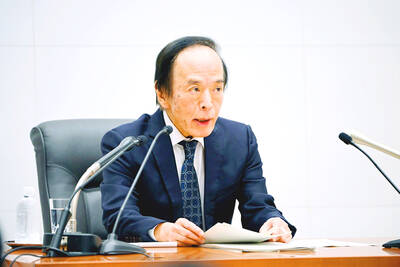Japan saw its biggest year-on-year jump in foreign workers since records began, government data showed yesterday, as the country seeks to address labor shortages exacerbated by its aging population.
In October last year, the nation’s foreign workforce stood at 2.3 million — an increase of around 254,000 people, or 12.4 percent, from a year earlier, Japanese Ministry of Health, Labor and Welfare data showed.
That marks the biggest jump since records began in 2008, and is the latest in a series of annual record-breaking increases.

Photo: EPA-EFE
The total has jumped around threefold from a decade ago, in 2014, when the number of foreign workers stood at 788,000.
The number of businesses employing at least one foreign worker also hit a record high of around 342,000, up 7.3 percent from a year ago, data showed.
Japan has the world’s second-oldest population after Monaco, according to the World Bank, and its relatively strict immigration rules mean it faces growing labor shortages. The aging nation will need 6.88 million foreign workers in 2040 to meet its growth targets, according to an estimate by the Japan International Cooperation Agency.
Yesterday’s data showed Vietnamese, Chinese and Filipinos were the top three nationalities in Japan’s foreign labor force. Japan also saw a surge in foreign workers from Myanmar, Indonesia and Sri Lanka last year, many of whom were blue-collar workers or students rather than high-skilled professionals.
Among the most common jobs held by foreign workers were positions in the manufacturing, hospitality and retail sectors.
A “technical intern” program continued to account for a sizeable portion of the foreign workforce, at 20.4 percent. The state-sponsored scheme is ostensibly an attempt by Japan to give participants from countries such as China and Vietnam specialized experience to use in their home countries.
However, critics have long called it a “backdoor” source of foreign labor in a conservative nation loath to officially acknowledge it is open to immigrants.
The intern program has also been long dogged by allegations of discrimination and physical abuse.

Taiwan’s long-term economic competitiveness will hinge not only on national champions like Taiwan Semiconductor Manufacturing Co. (TSMC, 台積電) but also on the widespread adoption of artificial intelligence (AI) and other emerging technologies, a US-based scholar has said. At a lecture in Taipei on Tuesday, Jeffrey Ding, assistant professor of political science at the George Washington University and author of "Technology and the Rise of Great Powers," argued that historical experience shows that general-purpose technologies (GPTs) — such as electricity, computers and now AI — shape long-term economic advantages through their diffusion across the broader economy. "What really matters is not who pioneers

In a high-security Shenzhen laboratory, Chinese scientists have built what Washington has spent years trying to prevent: a prototype of a machine capable of producing the cutting-edge semiconductor chips that power artificial intelligence (AI), smartphones and weapons central to Western military dominance, Reuters has learned. Completed early this year and undergoing testing, the prototype fills nearly an entire factory floor. It was built by a team of former engineers from Dutch semiconductor giant ASML who reverse-engineered the company’s extreme ultraviolet lithography (EUV) machines, according to two people with knowledge of the project. EUV machines sit at the heart of a technological Cold

TAIWAN VALUE CHAIN: Foxtron is to fully own Luxgen following the transaction and it plans to launch a new electric model, the Foxtron Bria, in Taiwan next year Yulon Motor Co (裕隆汽車) yesterday said that its board of directors approved the disposal of its electric vehicle (EV) unit, Luxgen Motor Co (納智捷汽車), to Foxtron Vehicle Technologies Co (鴻華先進) for NT$787.6 million (US$24.98 million). Foxtron, a half-half joint venture between Yulon affiliate Hua-Chuang Automobile Information Technical Center Co (華創車電) and Hon Hai Precision Industry Co (鴻海精密), expects to wrap up the deal in the first quarter of next year. Foxtron would fully own Luxgen following the transaction, including five car distributing companies, outlets and all employees. The deal is subject to the approval of the Fair Trade Commission, Foxtron said. “Foxtron will be

INFLATION CONSIDERATION: The BOJ governor said that it would ‘keep making appropriate decisions’ and would adjust depending on the economy and prices The Bank of Japan (BOJ) yesterday raised its benchmark interest rate to the highest in 30 years and said more increases are in the pipeline if conditions allow, in a sign of growing conviction that it can attain the stable inflation target it has pursued for more than a decade. Bank of Japan Governor Kazuo Ueda’s policy board increased the rate by 0.2 percentage points to 0.75 percent, in a unanimous decision, the bank said in a statement. The central bank cited the rising likelihood of its economic outlook being realized. The rate change was expected by all 50 economists surveyed by Bloomberg. The